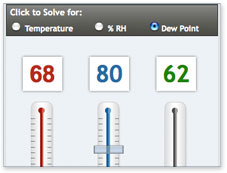How to Use: Step 1 — Interaction of T, RH, and DP
|
Interaction of T, RH and DP |
|
|
|
| |
Definitions: |
Temperature (T): A measure of heat energy, expressed in degrees Fahrenheit (F) or Celsius (C). Heat energy drives chemical reactions.
Relative Humidity (RH): A measure of how saturated the air is with water vapor, the %RH determines the amount of water contained within collection objects.
Dew Point: A measure of the absolute amount of water in the air, the DP is the temperature at which the air cannot hold all the moisture in it and water condenses.
Without humidification (the addition of moisture) or dehumidification (the removal of moisture), the indoor DP is the same as the outdoor DP.
|
|
| |
Every environment has exactly one combination of temperature (T), relative humidity (RH) and dew point (DP). Change any of these variables and you will have a different environment.
Use the DP Calculator to:
- Determine what the Dew Point in your space is – enter the T & RH and solve for DP
- See what combinations of T & RH are possible when you change the DP—the DP determines which temperature will give you which RH
How are T, RH, and DP related?

- At constant Temperature:
The RH and DP will increase or decrease together
- At a constant Relative Humidity:
The T and DP will increase or decrease together
- At a constant Dew Point:
As the T increases, RH decreases
As the T decreases, RH increases
How do T, RH, and DP determine preservation quality?
- High temperatures (generally above 75°F/24°C) increase the rate of chemical reactions, which determines how fast or slow organic materials will decay or "naturally age".
- Cool temperatures slow the rate of chemical decay. Lowering the T can improve preservation IF you also maintain an appropriate RH (determined by the dew point).
- At higher temperatures biological activity (insects, mold growth) increases.
- High RH (generally over 65%) can result in mold, metal corrosion, and mechanical damage.
- Low RH (generally below 35%) can result in mechanical damage.
- Wide and frequent RH fluctuations influence the rate of mechanical decay.
- The DP determines which T will give you which RH.



